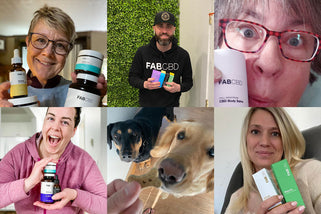It’s one thing to do your research to find a reputable CBD oil brand, it’s quite another to delve deeper into how that brand’s CBD oils are made. When you take the time to find out how a CBD oil is created, you’re not only arming yourself with more knowledge about the CBD industry in general, but you’re also confirming that the products you’re buying from the brand you’ve chosen are clean, potent, and effective.
Where Does CBD Oil Come From?
The quick and simple answer is that CBD oil is made from hemp extracts and a carrier oil. Farmers harvest the hemp plants and then scientists extract cannabinoids, terpenes, and phytonutrients from the stalks, leaves, and flowers. Then a carrier oil is added as the main liquid part of the product.
CBD Oil Extractions: There’s More Than One Way

There are three main ways to obtain extracts from hemp. While each method has its own set of pros and cons, not all of the methods are equally as clean and effective. The most common methods to extract CBD oil are carbon dioxide (CO2) extraction, steam distillation, and solvent extraction. The CO2 extraction method is the cleanest method and the one that’s most preferred throughout the CBD industry. Learn more about extraction methods in detail below.
Carbon Dioxide (CO2) Extraction Method
As far as extraction methods go, the CO2 extraction process is currently the gold standard, and industry preferred method for obtaining clean, potent, and pure extracts. Most reputable brands use this method to ensure that only the best, most cleanest extracts go into the making of their CBD products. There are, however, other methods of extracting CBD from hemp. These methods all have their pros and cons, but they do not yield as clean of an extract as the CO2 method does. In this method, carbon dioxide is used to separate CBD oil from the hemp plant’s material. This process results in an extract that contains high concentrations of CBD. This method is also perfect for creating specific concentrations of CBD oil. FAB CBD uses the industry-preferred CO2 extraction process to obtain all of its potent, pure, and effective CBD oils. These oils are then turned into the premium products that customers know and love. FAB CBD’s full-spectrum oils come in strengths of 300mg, 600mg, 1200mg, and 2400mg, and in smooth, tasty flavors of vanilla, mint, citrus, berry, and natural. And most recently, FAB CBD has added 2400mg full-spectrum CBD+CBG oil to its highly-rated and popular CBD oil lineup.
Other Methods of Extraction
- Steam Distillation Extraction: Steam distillation is an intricate and intriguing process. In this method, steam is used to separate the CBD oil from the hemp plant. While the steam distillation method is something that’s been regularly used throughout the industry in the past, more brands have moved over to CO2 extraction because steam distillation has been proven to be inefficient. Steam distillation is no longer an ideal way to extract CBD oil because it requires that a huge amount of hemp plant be used, and when compared to the CO2 extraction process, it’s harder to obtain exact amounts of CBD concentrations through steam distillation. If the steam becomes too hot, it can ruin the CBD extract by changing the chemical properties of its cannabinoids.
- Solvent Extraction: The solvent extraction process follows very much the same process that steam distillation does, however, it uses a solvent to separate the CBD oil from the hemp plant instead of water. Solvent extraction creates a mixture of CBD and solvent. As the solvent evaporates, pure CBD oil is left behind. Solvent extraction is sometimes found to be more efficient and cheaper than steam distillation. Sadly, some less-reputable brands use this method. And depending on which types of solvents they use, there is the potential for their CBD extracts to be laden with harmful chemicals. In order to avoid this from happening, some brands opt to use natural solvents like olive oil or ethanol in their solvent extraction methods. There are, however, disadvantages to natural solvent extraction. For example, when ethanol is used, chlorophyll can also be extracted from the CBD oil, giving the end product an unpleasant taste. Finally, because natural solvents don’t evaporate well, the resulting CBD oils will have a lower potency.
Types of CBD
CBD can be generally broken down into three categories, based upon the cannabinoid content. Ranging from the most complete profile of hemp elements to the most specific and thoroughly parsed out ingredients, what we call "CBD" can be in full spectrum, broad spectrum, or isolate form.
Full Spectrum CBD
Full spectrum CBD includes all the cannabinoids, terpenes and phytonutrients (plant-made nutrients) that are found in the hemp plant. Nothing has been screened out or removed. This is the form of CBD that allows for the entourage effect, which a a synergistic action amongst the various hemp plant elements that bolsters all of their positive qualities.
Broad Spectrum CBD
Broad spectrum CBD is very similar to full spectrum, except that the THC has been removed. When CBD is made from the hemp plant, there is already very little THC included, but for those with THC allergies or concerns, this is a great option. Most of the cannabinoids and terpenes are still present, so while the entourage effect may not be as powerful as with full spectrum, it can still take effect.
CBD Isolate
CBD isolate is just 99% pure cannabidiol. There are no other cannabinoids or phytonutrients included. It is the most narrowly defined CBD base out there.
How FAB CBD Oil Is Made

As we stated earlier, FAB CBD uses the industry-preferred, clean and efficient CO2 extraction process to obtain all of its pure and potent extracts. All of FAB CBD’s clean hemp is cultivated on over 1,000 acres of pristine Colorado farmland. After the hemp is harvested, it goes through the CO2 extraction process where all of its CBD, terpenes, cannabinoids, flavors, and phytonutrients are carefully preserved.
Next, the CBD oil is mixed with natural flavorings that have been created to compliment each strength so that the flavor of the full-spectrum oil you purchase still shines through despite the oil’s potency. Remember, the higher the concentration of oil, the “hempier” it will taste. The entire extraction and creation process is done in FAB CBD’s FDA registered, USDA Organic Certified Colorado lab and facilities.
Once FAB CBD’s full-spectrum oils have been formulated, they are then bottled, capped, and sealed. The final products are next shipped to FAB CBD’s Midwest facility in Milwaukee, Wisconsin, where both shipping and HQ are located. The 200,000 square foot facility is where thousands of orders are shipped out each day with some of the fastest shipping times in the industry. Every single one of FAB CBD’s products is routinely tested by ProVerde Labs, an independent third-party laboratory, for potency and purity. Customers can easily find all of those lab reports right on the FAB CBD website.
FAB CBD Wants the Best for Its Customers

The team at FAB CBD works hard to ensure that all of our customers have access to our high-quality CBD products while having the smoothest possible experience. FAB CBD uses cutting edge equipment and practices to make sure that all of its Colorado-grown hemp is free from pesticides, herbicides, fungicides, heavy metals, and other harmful chemicals. Along with clean hemp, we also use the industry preferred CO2 extraction process to obtain all of our pure and potent extracts. From growing, to harvesting, extraction, product creation, bottling, capping, and sealing, FAB CBD follows the best practices in the industry.
When it comes to figuring out what to look for in a CBD oil, always do your due diligence and spend some time researching the brand, the product, and CBD in general. Read any and all third-party lab reports posted by the brand, know where the brand sources its hemp from, and with which methods the brand uses to obtain its hemp extracts. Moreover, avoid less reputable brands that sell cheaply-made products. Additionally, you should also avoid brands that are not transparent or forthright about their creation process, the ingredients in their CBD products, and who make wild claims about what CBD and what it can do for your health. When looking into brands, along with third-party lab reports, you should also read verified customer reviews as well as the words of respected CBD industry journalists and experts. The little details you learn will help you to understand the bigger picture about both the brand and its products, and whether or not that brand is worthy of your hard-earned money and your valuable time.







